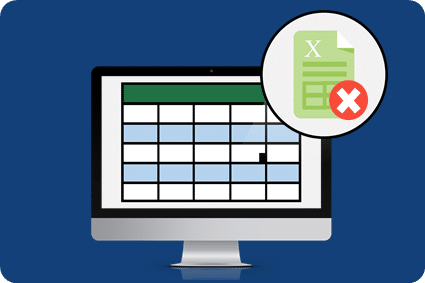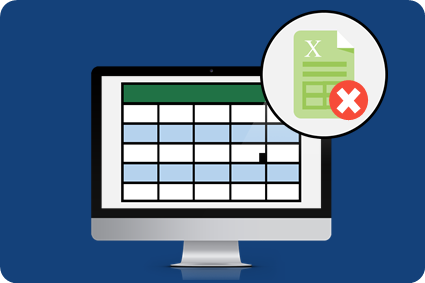Excel is Not the Best Solution for New Lease Accounting Reports (IFRS 16 & US GAAP)
Updated 18th June 2021 | 8 min read Published 19th January 2016

It’s without a doubt that Excel is a powerful business tool that, if used correctly, can perform a large number of useful and practical tasks.
It’s widely accessible and employees are often familiar with the vast array of functions the software provides – it’s the reason why the application is loved by businesses from all corners of the globe.
However, as the business and technological landscapes converge and alternatives emerge, does the humble Excel spreadsheet still cut it as the best way to store, manage and organise lease portfolios?
The answer is No.
Many organisations start off utilising Excel to manage their lease data, but as businesses evolve and their lease portfolios expand with them, Excel’s pitfalls become evident. Many of the world’s leading brands have realised this and are now using cloud-based lease management software instead.
Excel No Match For Lease Accounting
With the International Accounting Standards Board recently publishing IFRS 16 Leases – outlining the changes to the way leases are accounted for on company balance sheets – businesses will need to gather and review data for their active leases. Leading accountancy professionals have already warned of the potential challenges that businesses may face if they do not have an appropriate system for collecting and reporting on their leases to comply with the required financial statements:
|
|
“But the real challenges start now and the volume of work in the lead up to a 2019 implementation must not be underestimated.” |
|
|
“There is much work for companies to do to understand and implement the changes, not least in the area of data collection, and this work should be started sooner rather than later.“ |
|
|
“However, adopting it in time for the 2019 effective date will still be a challenge for some companies.” |
Attempting to collect, analyse, store and report on all active leases manually is a foolish undertaking, particularly for businesses that have numerous leases that could be split across different departments and geographies. Excel may be a jack of all trades, but in order to maintain full compliance once the US$2.8 trillion global lease commitments are added to balance sheets in time for the start of 2019, businesses are going to need a more masterful software to ease the cost and processing burdens of the new lease accounting standard.
Why Excel No Longer Cuts It
So when it comes to managing complex lease portfolios, there are a number issues to be aware of when considering Excel as your primary lease management and organisation tool:
– Susceptible to Human Errors:
– Experience Required:
– Not Specialised for Lease Management:
Excel has been developed as a one-size-fits-all business solution that can tackle numerous tasks, which has led to its unquestionable popularity and success. From savings reports through to Movemeber sign up sheets, excel is the go to application. However, it’s this diversity that limits the platform and makes it insufficient for more specific tasks, such as managing lease portfolios.
Lease tracking and reporting can be difficult and lease terminations may be overlooked. Utilising a more effective, responsive platform for managing your leases could prove invaluable and help improve business efficiencies. Just think how many resource hours are wasted each week maintaining these complex spreadsheets.
– Difficult to Adapt:
As a business’s lease asset portfolio expands, the requirement for spreadsheets to evolve dramatically increases. When formulating a Excel spreadsheet, you need to think of exactly how your organisation is going to use and manipulate the data in advance; once it’s set up, making any changes is difficult and often result in an entirely new spreadsheet.
Unlike cloud-based software, Excel is not scalable to your business’s growth and development. Alternative approaches are more intuitive and suited to expand with your business, rather than remain static. Plus, cloud access removes the potential problems of having adapt muiltiple excel sheets and duplicates that may be spread across the company.
– Not Suitable for Multiple Users:
Excel as a standalone application for individuals is great. However, when applied in a business environment, where multiple users and departments require access to the same spreadsheets, it can cause confusion and increase the likelihood of data misinterpretation. Unless access is restricted amongst employees, spreadsheets will always be prone to errors and you cannot guarantee that you always have the latest version. This inhibits the ability to make fast, proactive, data-driven decisions as the reports may be saved on someone else’s computer.
– Data Overload:
For small data sets, Excel could be considered the perfect tool. However, users will start experiencing performance issues when the data set becomes too large. It becomes confusing when multiple worksheets are added or lease data is dispersed across different spreadsheets, managed by various users. Simple tasks become a scavenger hunt and tracking the most relevant, up-to-date information becomes problematic, time-consuming and costly. With Excel’s limited search and filtration tools, finding exact data can mean the difference between real-time and dated decision making.
– Issues with Tracking and Audit Trails:
Excel has limitations when it comes to determining audit trails. It can prove difficult to find out who made decisions and on what dates. Updating and maintaining lease portfolios can be hard; tracking upcoming lease end dates, changes to lease terms, terminations and renewals is difficult using an application not specifically designed for lease management.
Lease inception and contract negotiation are vitally important in producing the most optimised lease agreements. Being able to track and complete all actions in this negotiation stage cannot be understated, however, this must all be done manually in Excel.
– Compliance:
Due to Excel’s limitations in regard to tracking, reporting, audit trails, and the lack of specialised lease accounting calculation tools. These drawbacks have a knock on effect whereby maintaining full lease accounting compliance becomes challenging. Companies may find investing in lease management software solves a lot of these issues. With the need to produce comparative balance sheet and P&L reports for active leases during the transition, lease accounting software can help run all the financial reports for you.
Click here for more on Changes to IFRS Lease Accounting
– Hinders Quick Decisions:
With a multitude of spreadsheets distributed across various departments, making effective business decisions with regard to lease agreements, terminations and renewals is a challenge. Extracting data from various sources and reviewing the information so that the relevant decision makers, whether in procurement, logistics, operations or finance, is time consuming and laborious.
– Lack of Scalability:
As a business grows and data volumes expand, it’s reasonable to expect that platforms scale accordingly. With Excel, what once was a powerful and useful application, soon becomes limited and inept and the distinct lack of scalability become a hindrance.
Data is highly distributed amongst worksheets and different files. Managing and comparing all this efficiently can be a logistical nightmare. Running a report, such as a lease portfolio review, can take weeks and involves a great deal of manual work – this can be completed at the touch of a button with specialised SaaS/Cloud software.
– Inadequate Customisation:
Being an out of the box application to suit many business needs, a pitfall of Excel is that the system can’t be tailored to suit your core business requirements. Whereas with cloud-based lease management solution alternatives, more often than not the software can be customised to meet any organisations unique requirements and also be adjusted to compliment internal structures.
– Susceptible to Fraud:
With a large number of users working on any given spreadsheet within an organisation, they are inherently subjectable to fraud. The apparent lack of control offered by the system means data values, cells and formulas can be easily changed and it’s difficult to detect what has been changed, let alone who’s making the alterations.
So What’s The Alternative?
Luckily, we live in a world where software and technological advancement is common place and there are many alternative operating systems and applications available to businesses looking to switch once their business needs have outgrown Excel.
Many leading brands are turning to specialised cloud-based lease management software to maintain their asset portfolios. The main advantage to software of this nature is that it’s designed specifically for managing leases, offers greater scalability, integrated alerts, full audit trails and secure data storage, along with specialised features that help maintain full lease accounting compliance, and can be easily tailored or customised to meet any organisations business requirements.
For more information, download our guide to lease management software here.
Share this Article?




